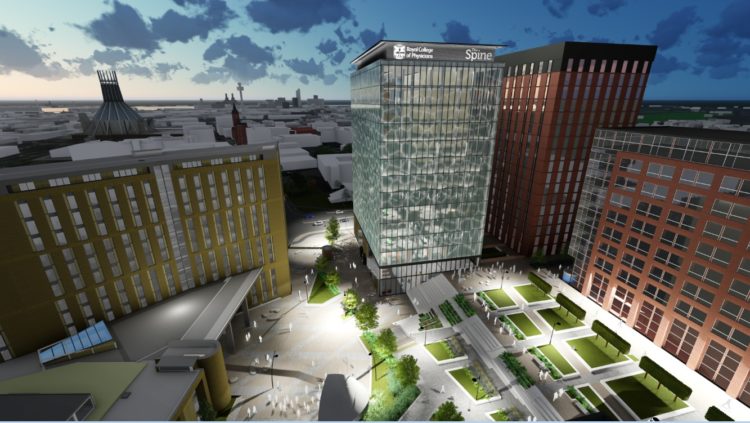Latest Office Market Review, compiled by Professional Liverpool and Liverpool BID Company, says available space in the commercial district contracted by 33% during 2019. Tony McDonough reports

Liverpool commercial district’s office space pipeline hit an all-time low in 2019 with the city now missing out on major letting opportunities.
The latest Office Market Review, compiled by Professional Liverpool and Liverpool BID Company, says available space in the commercial district contracted by 33% during the year, falling to 475,351 sq ft.
And concern over the lack of grade A space is a particular worry to city centre agents and those charged with attracting inward investment into Liverpool. The newest space in the commercial district is at No 4 St Paul’s Square and 20 Chapel Street. Although of high quality, both buildings are now too old to be classed as grade A.
The next available grade A space in the city centre will be at The Spine in Paddington Village in autumn 2020 and proposed new office space at Pall Mall and Liverpool Waters has yet to come out of the ground.
Andrew Byrne, head of the property group at Professional Liverpool, said: “We continued to see downward pressure on the supply chain, particularly within the commercial district which contracted by over 33% and hit a record all time low of 475,351 sq ft.
“The need for grade A supply is growing year on year and the lack of speculative development is meaning larger footloose requirements are dismissing Liverpool as an option in the short to medium term.”
Liverpool has the lowest headline rents for grade A accommodation among the big nine regional cities outside London – £21.50 per sq ft. The second-lowest, Newcastle, has now climbed to £26 per sq ft, while Manchester is racing ahead at the top with £36.50 per sq ft. The average across the nine is £31 per sq ft.
Headline rents are a crucial figure for developers and investors. If they are too low, as they are in Liverpool right now, there is too little incentive for developers to build new office space speculatively.
A report in January by Avison Young claimed a requirement for 100,000 sq ft from BT in the city could push rents above the crucial £25 per sq ft mark. The telecommunications giant is believed to be considering either The Spine or a pre-let at Pall Mall.
According the Office Market Review, more than 567,000 sq ft of commercial space was taken as office space in Liverpool city region in 2019, 60% of which was taken in Liverpool’s Commercial District, with a total of 166 deals.

The biggest deal in Liverpool’s Commercial District in the past 12 months was Sony taking 65,000 sq ft in the former Liverpool Echo building. The largest deal in Liverpool city region was Greensill’s letting of 27,000 sq ft at Daresbury Park 2100, following a £1.6m refurbisment.
Demand for office space in Liverpool remains at a five-year constant, but dips against the record breaking year of 2018, which saw the £125m sale of India Buildings following the 350,000 sq ft letting to HMRC, which significantly boosted the year’s figures.
Overall office take up with Liverpool city region was 567,793 sq ft in 2019, marginally lower than the five year average of 637,871 sq ft. Within Liverpool city centre (L1, L2 and L3), office take up was 400,454 sq ft.
There is also growing demand for more flexible space in the commercial district, with many smaller occupiers looking for short term flexible spaces as they establish their business. Liverpool remains an attractive prospect for investors, with rental values reaching levels £21-£25 per sq ft.
Bill Addy, chief executive of Liverpool BID Company, added: “The office market has performed strongly in the past five years, and it’s encouraging to see the trend continue, especially after 2018’s record breaking year. Take-up levels remain positive and the balance across smaller and larger lettings shows the health of the market and spread of business.
“We recently partnered with Liverpool City Council on developing the Commercial District Spatial Regeneration Framework (SRF) identifying what the area needs to grow and develop further. Grade A office space is a must for Liverpool’s commercial district. Liverpool Waters and the Pall Mall development are a welcome addition, but we continue to need new developments that offer choice for businesses to come to Liverpool”.
The data from the Office Market Review reflects Liverpool’s businesses are growing. For the past five years, whilst the number of transactions for office take up has reduced, there has been an increase in the size of transactions – the average size of a deal in 2014 in the Commercial District was 3,209 sq ft, while in 2019 the average size was 4,040 sq ft.
Liverpool’s business market continues to be evenly spread across all sizes, with a particular growth in smaller lets (under 2,500 sq ft) suggesting a robust SME community.
And 73.5% of all lettings in the commercial district were below 2,500 sq ft. There were 12 transactions over 5,000 sq ft and four deals above 20,000 sq ft, compared with three in 2018.

In line with other regional cities, investment volumes and activity were markedly reduced owing to wider political uncertainties which overshadowed 2019. The year’s common theme was of owners showing a reluctance to openly market their properties, fearing that political uncertainty could negatively impact pricing despite the strong fundamentals locally in respect of business, occupational and development growth.
Despite this, there was a major transaction with the sale of Exchange Flags by Shelborn Asset Management to Ashtrom Properties for a price of approximately £68m reflecting a net initial yield of 7.65%. The sale demonstrates the improvement in both the occupational and investment markets since the property last transacted in 2016 for £42m.
This improvement was also shown by the sale of 5 Temple Square for £7.5m reflecting a net initial yield of 7.20%, again higher than when the property last transacted in 2015 for £5.7m in 2015. Liverpool’s prime office yield currently sits at 6.25% and relative pricing between Liverpool and other major regional cities remains attractive for investors.

